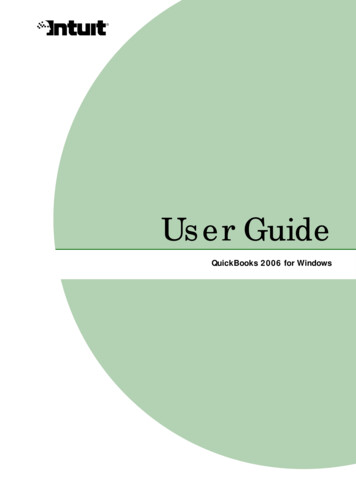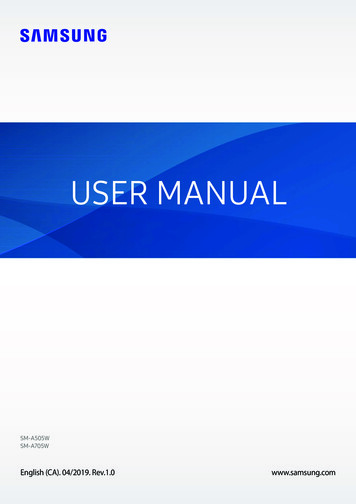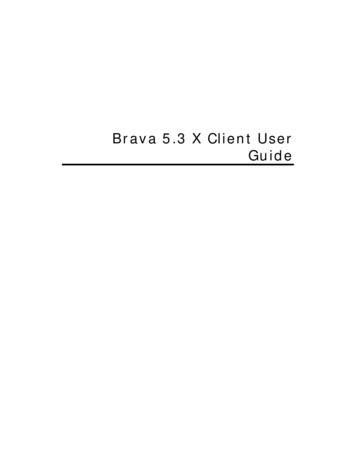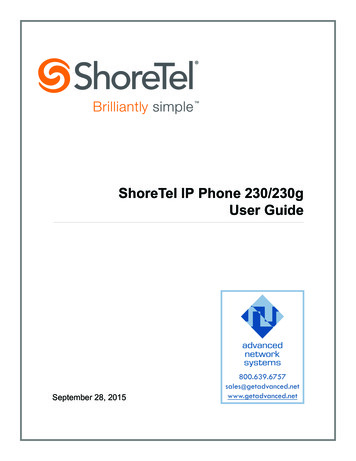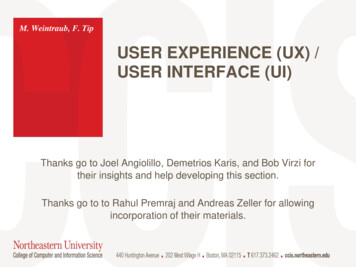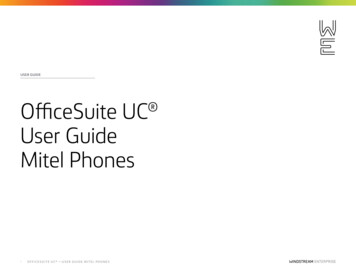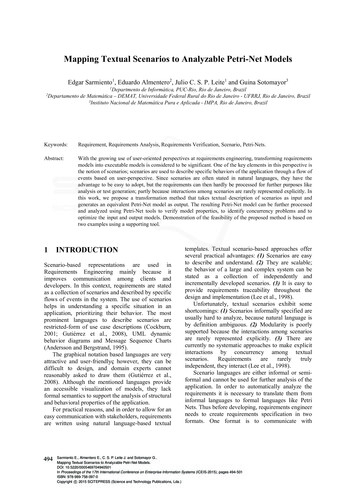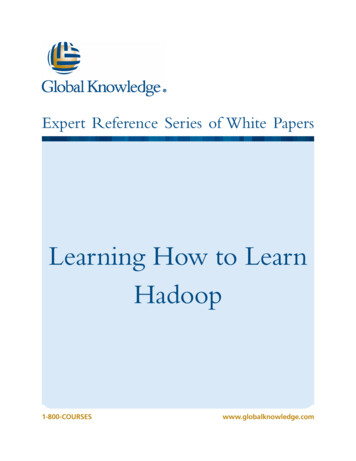
Transcription
computer law & security report 22 (2006) 454–463available at tions/prodclaw.htmRegulating the InternetNet neutrality: A user’s guide5Paul Ganley, Ben AllgroveBaker & McKenzie LLP, LondonabstractNet neutrality is a complex issue that has generated intense levels of political discussion inthe United States, but which has yet to attract significant attention from regulators in theUK. Nevertheless, the question of whether network operators should be preventedfrom blocking or prioritising certain network traffic or traffic from particular sources is asignificant one for a wide range of stakeholders in the digital networked economy. Networkoperators contend that the build costs for the next generation of networks are so high thatthey must be permitted to monetise their control over this infrastructure as efficiently aspossible. Meanwhile, an eclectic mix of interests including content and service providers,free speech and special interest groups and entertainers, argue that net neutrality regulation is necessary to guarantee that the Internet’s core values and social utility arepreserved. This article offers an introduction to net neutrality from a UK perspective. Theauthors explain the technical, commercial, political and legal considerations that underpinthe issue and suggest that, whilst net neutrality regulation in its strongest incarnation isnot practical or desirable, a level of regulatory action designed to enhance the choices ofend users is the best way forward.ª 2006 Baker; McKenzie LLP. Published by Elsevier Ltd. All rights reserved.1.IntroductionControlling who gets the fast lane is tantamount to givingcontrol.1In 1999 Cisco introduced a new type of router thatenabled network operators (‘‘operators’’) to inspect datapackets flowing through their networks. The router allowsoperators to prioritise or de-prioritise certain packets of5data or even drop them from their network altogether.This technology, and its more advanced successors,2 allowoperators to choose how to handle data packets for commercial or policy reasons as opposed to the network performance reasons originally envisaged by Cisco. Packets canbe favoured because they originate from a preferred source.Likewise packets can be de-prioritised or even blocked simply because they originate from a non-preferred source.This prioritisation or de-prioritisation of data packets isThe views expressed in this article are the authors’ own and do not necessarily reflect the views of Baker & McKenzie LLP or itsclients. All errors and omissions remain the sole responsibility of the authors.1A Davidson, Google’s Washington counsel, as quoted in R Ascierto, ‘U.S. House Neuters Net Neutrality’ ComputerWire (12 June 2006).2A recent brochure from Cisco for an application called Cisco Service Control Engine describes a ‘‘deep packet-inspection engine’’ thatallows network operators to ‘‘identify, classify, monitor and control traffic’’ through an ‘‘application-aware and subscriber-aware’’ system. Underneath the jargon lies an Internet policy that suggests discrimination based on the users and uses of the network. See ‘CiscoService Control: A Guide to Sustained Broadband Profitability’ (Cisco White Paper, 2005) available from: Profit.pdf.0267-3649/ – see front matter ª 2006 Baker; McKenzie LLP. Published by Elsevier Ltd. All rights reserved.doi:10.1016/j.clsr.2006.09.005
computer law & security report 22 (2006) 454–463often dubbed ‘‘access tiering’’ and it is at the core of the‘‘net neutrality’’ debate.3The ability to handle data on different network tiers has ignited a high-profile debate in the United States about whetheror not operators should be allowed to discriminate betweendata packets and, therefore, whether regulatory interventionis needed to constrain how operators run their networks.This debate has prompted many to reconsider what publicinterest values are promoted by a ‘‘non-discriminatory’’ or‘‘neutral’’ Internet and whether access tiering threatens thatpublic interest. Importantly, the net neutrality debate is onewhich is now gaining traction in Europe. It is a debate whichtakes place in the context of various recent episodes that raisesimilar policy questions. Episodes such as Yahoo!’s dealingswith the French courts on the question of the sale of Nazimemorabilia,4 Google’s forays into China5 and the debateabout who should control ICANN.6 These episodes force governments, and society, to confront the question of how andwhether the Internet should be regulated.The net neutrality debate is often framed as having justtwo sides. On one side are the operators. In the US, the mostvocal of these have been companies like AT&T, Verizon andComcast. The operators argue that the increasing demandsplaced on the modern Internet require a level of investmentthat can and will only occur if the Internet is efficiently commercialised. They say that this commercialisation mustinvolve the ability to implement a ‘‘user pays’’ model for theuse of their networks and, hence, the Internet; those whomake high use of and profit from the Internet, should, the operators say, pay for that use.The other side of the debate is more complex and ischaracterised by an eclectic coalition of content and serviceproviders, such as Google, Intel, Yahoo!, eBay and Amazon,anti-regulation advocates, entertainers, like REM and Moby,free speech groups, like Free Press, and others such as theChristian Coalition, National Religious Broadcasters and theGun Owners of America. The message that these groups andindividuals send out is that access tiering threatens the corevalues and social utility of the Internet and that governmentsmust intervene to prevent access tiering from occurring.3The net neutrality debate is often characterised by the use ofemotive terms such as ‘‘discrimination’’, ‘‘neutrality’’, ‘‘freedom’’and ‘‘democracy’’. The use of such rhetoric often clouds consideration of the issues at play because it elides what are often quitenuanced and diverse issues into bi-polar ‘‘pro’’ and ‘‘con’’ camps.Further inflated claims foretelling the end of the Internet, thestagnation of broadband deployment and the death of freespeech often characterise this debate. The authors prefer, wherepossible, to use the technological term ‘‘access tiering’’ becauseit is objective, allowing the pros and cons of the technologicalability to prioritise and de-prioritise data packets to be assessedwithout falling into the trap of over-simplification.4L.I.C.R.A and U.E.J.F v. Yahoo Inc. and Yahoo France, InterimCourt Order, Paris County Court (20 November 2004).5See Clive Thompson, ‘Google’s China Problem (And China’sGoogle Problem)’ New York Times (23 April 2006) available ¼5090.6See ‘Who owns the web?’ The Sunday Herald (20 November2005), p. 24.455In this article, the authors tackle the net neutrality debate.In doing so, they show that net neutrality is not simple andbi-polar. Rather, it is a complex and fascinating issue thatmust meld the public interest with legal, practical and commercial considerations. At the end of the day, there is noinherently ‘‘correct’’ position. Compromises must be soughtand reached. These compromises must balance the increasingdemand for investment which the modern Internet occasionswith the genuine concerns that the sourcing of that investment should not undermine the largely unfettered exchangeof information that has characterised the development ofthe Internet to date and which, in the minds of many, iswhat has made the Internet such a powerful social force insuch a short space of time.2.The technology2.1.Regulating the Internet: the ‘‘layers principle’’Before turning to discuss the net neutrality debate it is necessary to consider to what extent the Internet is currently, andcan be further, regulated.The idea that the Internet should be unregulated, and indeed could not be regulated, reached its zenith with the publication of John Perry Barlow’s ‘Declaration of the Independenceof Cyberspace’ in 1996.7 Barlow’s conception of the Internet asan independent ’space’ or institution has taken root with thosewho argue that the Internet should be ‘‘free’’ – both of government regulation and commercial distortion. As the Internethas developed, however, it has become increasingly clearthat it is subject to many of the same regulatory forces as othersocial institutions and fora.8 That the Internet can be regulatedand influenced (both by governments and those that operateits infrastructure) is no longer in issue; the question now beingasked is, should it be regulated, and if so, how?In order to understand how the Internet can be regulatedor influenced, one must understand the various ‘‘layers’’ ofInternet topology and how each of these layers is susceptibleto regulatory pressure.Broadly speaking, the Internet is comprised of three layers:the physical layer, the logical layer and the content layer. The content layer is made up of the content, information andother meaningful statements that individuals using the Internet perceive, act on, laugh at and share. The logical layer describes the series of algorithms andstandards – including TCP/IP, HTTP and HTML – that allowcontent layer materials to be understood and transmittedin machine readable form; it is one part of the ‘‘machinery’’of the Internet. The other part of that machinery is the physical layer, whichincludes the tangible objects – computers, wireless devices,7John Perry Barlow, ‘A Declaration of the Independence ofCyberspace’ (8 February 1996) available from: l (‘‘you weary giants of fleshand steel.you have no sovereignty where we gather’’).8See, e.g. Jack Goldsmith and Tim Wu, Who Controls the Internet:Illusions of a Borderless World (Oxford University Press 2006).
456computer law & security report 22 (2006) 454–463wires, routers etc. – that connect individuals to the Internetand one another.At each of these layers we witness controversy, influenceand regulation of varying kinds.At the content layer, these battles have primarily beenfought in the realm of the private enforcement of copyrightand other intellectual property (‘‘IP’’) rights. The result ofthese private enforcement battles has generally been governments strengthening laws to offer a narrower set of permitteduses of protected content and the increased criminalisation ofinfringement of IP rights. Operators, meanwhile, have successfully resisted attempts to make them function as ‘‘rightspolice’’ so long as they take reasonable measures to preventinfringement and act when infringement is brought to theirattention.9 Other battles at the content layer have been foughtaround database rights, pornography, gambling and defamation, to name but a few. The battles at the content layertend to be about translating physical world controls into thedigital medium.At the logical layer, these battles tend to focus on the technology which underlies the Internet. Examples include actionsagainst peer-to-peer software providers10; the controversysurrounding the implementation of anti-circumvention lawsin the US and the Europe; and the continual efforts to ensurethat the domain name system functions effectively.11 Anotherexample is the Free/Open Source Software (F/OSS) movementthat has been embraced by many software vendors and whichfavours open, but not necessarily free, access to some of thekey components of the logical layer.12At the physical layer, increasingly fractious arguments characterise the debate, including arguments about areas as diverseas free or low cost municipal wireless Internet (‘‘wifi’’) systems;the regulation of hardware – e.g. personal computers and otherdevices that process content – through the imposition of‘‘trusted system’’ architecture, such as the ‘‘broadcast flag’’ inthe United States; and the government’s ability to interceptcommunications and to control encryption technologies.Understanding these layers and the battles at play at eachof them, makes it instantly apparent that Internet regulationis about more than just law. Legal, technical, social and market based rules and norms interact to determine the dynamicsof the Internet. The net neutrality debate is no different. It isa debate about regulation and influence at the interface ofthe logical and physical layers. Before we delve into the detailsof the controversy, however, it is worth understanding whatthe physical Internet first looked like and how it continuesto look, largely, to this day.9Directive 2000/31/EC on Certain Legal Aspects of InformationSociety Services, in Particular Electronic Commerce, in the Internal Market, articles 12–15; Digital Millennium Copyright Act, x512.10See A&M Records, Inc. v. Napster, Inc. 239 F.3d 1004 (9th Cir.2001); A&M Records, Inc. v. Napster, Inc., 284 F.3d 1091, 1096 (9thCir. 2002); Metro-Goldwyn-Mayer Studios, Inc. v. Grokster, Ltd., 125S. Ct. 2764; and Universal Music Australia Pty Ltd v. Sharman LicenseHoldings Ltd [2005] FCA 1242.11See, e.g. Milton Mueller, Ruling the Root: Internet Governance andthe Taming of Cyberspace (MIT Press 2004).12See, e.g. Steven Weber, The Success of Open Source (HarvardUniversity Press 2004).2.2.The end-to-end principleThe Internet was designed as a ‘‘dumb’’ network. Its centralfunction – implemented via the TCP/IP protocols – is to passpackets of data, via ‘‘pipes’’, along a chain of ‘‘nodes’’ untilthey reach their destination. The nodes do not ask questionsabout the sender of the packet, the recipient, or its content;they simply receive them, analyse the address informationand pass them on to the next node. This dumb network treatsall packets equally – a principle referred to as ‘‘bit parity’’ andoften encapsulated in the phrase ‘‘end-to-end’’ design.13 Ina dumb network, intelligence is incorporated in the app
Regulating the Internet Net neutrality: A user’s guide5 Paul Ganley, Ben Allgrove Baker & McKenzie LLP, London abstract Net neutrality is a complex issue that has generated intense levels of political discussion in
